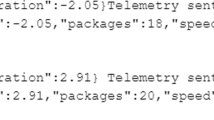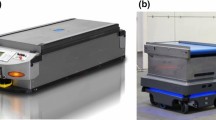Abstract
Deadlocks are an important problem in resource allocation systems such as flexible manufacturing systems. The theory of regions and the siphon-based method are usually used in the most deadlock prevention policies. The theory of regions that can obtain a maximally permissive controller is usually considered to be a natural solution with seasonable computational cost for flexible manufacturing systems. The selective siphon method allows one to use fewer control places than the conventional one. This paper employs both methods above. The former can identify the set of curial marking/transition–separation instance; the latter can reduce the computational cost. We can infer that the novel policy is the most efficient policy than the traditional methods, and also, the maximal permissive behavior of Petri net models can still be obtained.
Similar content being viewed by others
References
Hu H, Li Z (2009) Modeling and scheduling for manufacturing grid workflows using timed Petri nets. Int J Adv Manuf Technol 42(5–6):553–568
Tuncel G (2012) An integrated modeling approach for shop-floor scheduling and control problem of flexible manufacturing systems. Int J Adv Manuf Technol 59(9–12):1127–1142
Burnwal S, Deb S (2012) Scheduling optimization of flexible manufacturing system using cuckoo search-based approach. Int J Adv Manuf Technol. doi:10.1007/s00170-012-4061-z
Huang B, Shi XX, Xu N (2012) Scheduling FMS with alternative routings using Petri nets and near admissible heuristic search. Int J Adv Manuf Technol. doi:10.1007/s00170-012-3958-x
Abrishambaf R, Hashemipour M, Bal M (2012) Structural modeling of industrial wireless sensor and actuator networks for reconfigurable mechatronic systems. Int J Adv Manuf Technol. doi:10.1007/s00170-012-4070-y
Ezpeleta J, Colom JM, Martinez J (1995) A Petri net based deadlock prevention policy for flexible manufacturing systems. IEEE Trans Robot Autom 1:173–184
Huang YS, Jeng MD, Xie XL, Chung SL (2001) A deadlock prevention policy based on Petri nets and siphons. Int J Prod Res 39:283–305
Li ZW, Zhou MC (2006) Clarifications on the definitions of elementary siphons in Petri nets. IEEE Trans Syst Man Cybern Part A Syst Humans 36(6):1227–1229
Huang YS, Jeng MD, Xie XL, Chung TH (2006) Siphon-based deadlock prevention policy for flexible manufacturing systems. IEEE Trans Syst Man Cybern Part A Syst Humams 36(6):2152–2160
Huang YS (2007) Deadlock prevention for flexible manufacturing systems in sequence allocation systems. J Inf Sci Eng 23(1):215–231
Huang YS (2007) Design of deadlock prevention supervisors for FMS using Petri nets. Int J Adv Manuf Technol 35(3–4):349–362
Li ZW, Hu HS, Wang AR (2007) Design of liveness-enforcing supervisors for flexible manufacturing systems using Petri nets. IEEE Trans Syst Man Cybern Part C Appl Rev 37(4):517–526
Lautenbach K, Ridder H (1996) The linear algebra of deadlock avoidance—a Petri net approach. Research Report, University of Koblenz, Institute for Computer Science, Koblenz, Germany
Iordache MV, Moody JO, Antsaklis PJ (2001) A method for the synthesis liveness enforcing supervisors in Petri nets. In Proceedings of the American Control Conference pp 4943–4948
Park J, Reveliotis SA (2000) Algebraic synthesis of efficient deadlock avoidance policies for sequential resource allocation systems. IEEE Trans Robot Autom 16(2):190–195
Li ZW, Zhou MC (2004) Elementary siphons of Petri nets and their application to deadlock prevention in flexible manufacturing systems. IEEE Trans Syst Man Cybern Part A Syst Human 34(1):38–51
Li ZW, Zhou MC (2008) Control of elementary and dependent siphons in Petri nets and their application. IEEE Trans Syst Man Cybern Part A Syst Humans 38(1):133–148
Li ZW, Zhao M (2008) On controllability of dependent siphons for deadlock prevention in generalized Petri nets. IEEE Trans Syst Man Cybern Part A Syst Humans 38(2):369–384
Cho H, Kumaran TK, Wysk RA (2000) Graph-theoretic deadlock detection and resolution for flexible manufacturing systems. IEEE Trans Robot Autom 11(2):190–195
Uzam M (2002) An optimal deadlock prevention policy for flexible manufacturing systems using Petri net models with resources and the theory of regions. Int J Adv Manuf Technol 19(3):192–208
Uzam M (2004) Synthesis of feedback control elements for discrete event system using Petri net models and theory of regions. Int J Adv Manuf Technol 24(1–2):48–69
Uzam M (2004) The use of Petri net reduction approach for an optimal deadlock prevention policy for flexible manufacturing systems. Int J Adv Manuf Technol 23(3–4):204–219
Uzam M, Zhou MC (2007) An iterative synthesis approach Petri net-based deadlock prevention policy for flexible manufacturing systems. IEEE Trans Syst Man Cybern A Syst Human 37(3):362–371
Li ZW, Wang A, Lin H (2004) A deadlock prevention approach for FMS using siphon and the theory of regions. IEEE International Conference on System, Man, and Cybernetics pp. 5079−5084
Ghaffari A, Rezg N, Xie XL (2003) Design of a live and maximally permissive Petri net controller using the theory of regions. IEEE Trans Robot Autom 19(1):137–142
Ghaffari A, Rezg N, Xie XL (2003) Feedback control logic for forbidden-state problems of marked graphs: application to a real manufacturing system. IEEE Trans Automat Contr 18(1):18–29
Huang YS, Pan YL (2009) Enhancement of an efficient liveness-enforcing supervisor for flexible manufacture systems. Int J Adv Manuf Technol 48:725–737
Huang YS, Pan YL, and Jeng MD (2009) An efficient liveness enforcing supervisor for FMSs based on Petri nets and the theory of regions. Proceedings of the 2009 IEEE International Conference on Systems, Man, and Cybernetics San Antonio, TX, USA pp. 187−192
Huang YS, Pan YL (2011) An improved maximally permissive deadlock prevention policy based on the theory of regions and reduction approach. IET Control Theory Appl 5(9):1069–1078
Badouel E, Bernardinello L, Darondeau P (1995) Polynomial algorithms for the synthesis of bounded nets. In Proceedings of CAAP 95, vol. 915 of Lecture Notes in Computer Science pp 647−679
Badouel E, Darondeau P (1998) Theory of regions. Third advance course on Petri nets. Springer, Heidelberg
Ehrenfeucht A, Rozenberg G (1990) Partial (set) 2-structures, parts I–II. Acta Inform 27:315–368
Badouel E, Darondeau P (1996) On the synthesis of general Petri nets. INRIA Research Report No: 3025
Murata GT (1989) Petri nets: properties, analysis and applications. Proc IEEE 77:541–580
Li ZW, Zhou MC, Jeng MD (2008) A maximally permissive deadlock prevention policy for FMS based on Petri net siphon control and the Theory of Regions. IEEE Tran Autom Sci Eng 5(1):182–188
Wei N, Li ZW (2008) On the suboptimal liveness-enforcing supervisors based on Petri net structural analysis and the theory of regions. Int J Adv Manuf Technol 38:195–204
Li ZW, Zhou MC, Wu NQ (2008) A survey and comparison of Petri net-based deadlock prevention policies for flexible manufacturing systems. IEEE Trans Syst Man Cybern Part C Appl Rev 38(2):173–188
Piroddi L, Cordone R, Fumagalli I (2008) Selective siphon control for deadlock prevention in Petri nets. IEEE Trans Syst Man Cybern Part A Syst Humans 38(6):1337–1348
Piroddi L, Cordone R, Fumagalli I (2009) Combined siphon and marking generation for deadlock prevention in Petri nets. IEEE Trans Syst Man Cybern Part A Syst Humans 39(3):650–661
Huang YS, Pan YL, Jeng MD and Chang PL (2010) Enhancement of an deadlock prevention policy for FMSs using theory of regions. IEEE International Conference on System, Man, and Cybernetics pp. 304−309
Huang YS, Pan YL, Zhou MC (2012) Computationally improved optimal deadlock control policy for flexible manufacturing systems. IEEE Trans Syst Man Cybern Part A Syst Humans 42(2):404–415
Ramadge PJ, Wonham WM (1989) The control of discrete event systems. Proc IEEE 77:81–98
Abdallah IB, ElMaraghy HA (1998) Deadlock prevention and avoidance in FMS: a petri net based approach. Int J Adv Manuf Technol 14:704–715
A Petri net analysis tool, Software version 1.0 (1996) Pedagogical University of Rzesów, Polland
Author information
Authors and Affiliations
Corresponding author
Rights and permissions
About this article
Cite this article
Pan, YL., Huang, YS., Jeng, M. et al. Enhancement of an efficient control policy for FMSs using the theory of regions and selective siphon method. Int J Adv Manuf Technol 66, 1805–1815 (2013). https://doi.org/10.1007/s00170-012-4460-1
Received:
Accepted:
Published:
Issue Date:
DOI: https://doi.org/10.1007/s00170-012-4460-1




